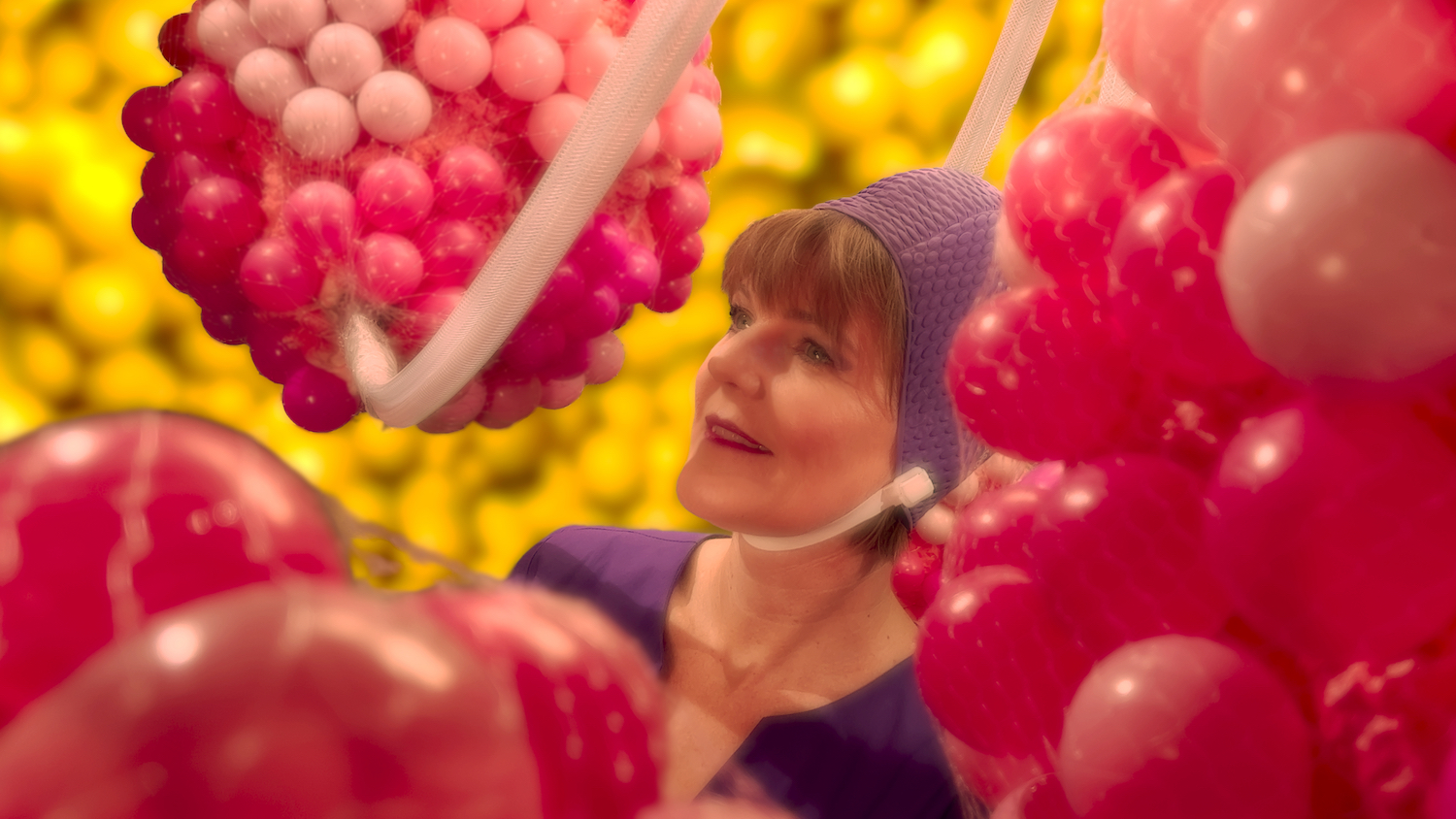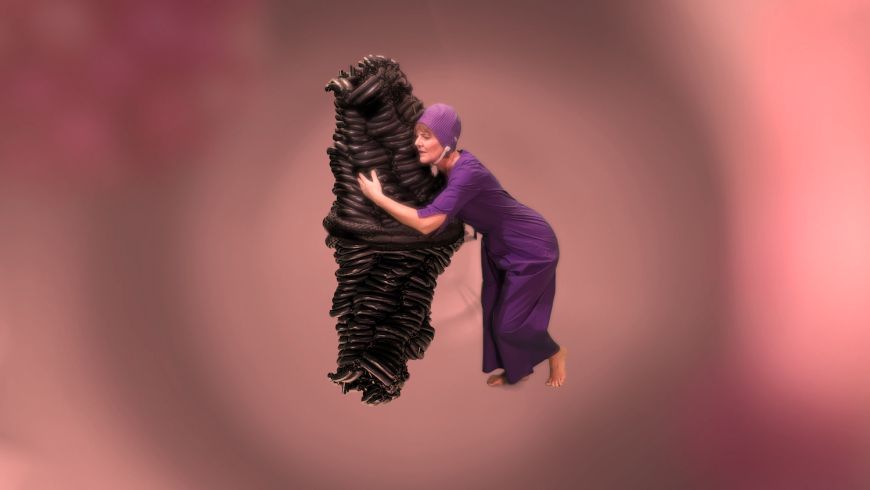Her Fantastic Voyage
Jessica Moriarty
From the scourge of illness to the succour of creativity and the solace of friendship, Jessica Moriarty’s essay charts a complementary companion path to Joanna’s Callaghan’s video.
Projects
Watch Joanna Callaghan's My Fantastic Voyage on FVU Watch
Reality is unmappable – too big, sprawling and changeable to be captured entire on paper or canvas. It is like trying to trap a giant squid with a rock pool net.
Macfarlane, 2018, p.33
Joanna’s film hits. Hits my heart, my head. It is a hugely evocative insight into her journey with (and also into) her body that is arduous, playful, moving, triumphant. The greyscale of the opening sees a patient – is it Joanna? Masked and in her chemo skullcap, we cannot be sure? – exhausted by the dehumanising drugs and processes synonymous with treatments for breast cancer. Scans and images that make the known (body) unknown, making visible the below the surface inhabitant who is somewhere they should not be – they were not invited here. The music and flashing images of a person in physical and emotional pain stirs memories held in my own body of my lived experience with cancer. Shakes them awake, asks that they be re-membered, insists I listen.
***
My friend and I got cancer within a year of each other – fuck you, cancer – and for the same and also for different reasons, it left us both feeling lost. Lost because we did not know who these sick women with cancer were and lost because we didn’t want to know them. Lost creatively because we felt our individual practice had been stifled – my friend because the paints she used in her artwork are known carcinogens, and me because I decided to ignore the cancer whenever I could, throwing myself into my work as a Creative Writing lecturer and raising my young family instead of sitting with the fact I had cancer and giving myself time and space to accept it. This left me little time to write and I realise now that this was deliberate: I was scared that if I wrote, the feelings and fears I had been denying would spill out onto the page, and I was worried about what I might do if they did.
My friend had a different approach. She wintered, hunkered down and avoided clamouring family and friends who wanted to tell her it would all be ok. This was what she had to do for her, but very selfishly I resented her self-imposed exile. I told her I had a book deadline and needed help. That the publishers were nagging me for a draft and I had nothing. Dubious but wanting to help her old friend, she reluctantly agreed to start a co-authored chapter – only one, mind – whilst repeatedly saying that she couldn’t commit to anything. That the future was suddenly a slippery eel that she neither wanted to hold onto, nor let go of.
Slowly chapters1 and then a book2 emerged from the cancer caves we had been in. We found a way of working that gave my friend the structure and discipline she needed to paint and write again and in return, she gave me a hand to hold as I finally – finally – went toe-to-toe with my experience of cancer. Joanna’s film reminds me that when we engage with our lived experiences creatively, and story ourselves, it can be transformative. Celia Hunt argues that for some women, ‘where the imagination sets to work on the raw material of the unconscious and turns it into art… engaging with their inner world has a strong self-developmental or therapeutic dimension.’ (2000, p.40) helping us to feel differently about events that we find troubling and hard.
I expressed some long felt and deeply felt emotion. And in expressing it I explained it and then laid it to rest.
Woolf, 1989, p.90
When my friend and I started our process, I wanted our creativity to reintroduce us to the women we were before cancer, for my jolly friend who liked rude jokes, boozy nights out and nattering at 100mph back to the way she was. But that’s not what happened. Like Joanna, what the process of creating offered us wasn’t a way to deny or escape cancer – my friend is back in the ring with it now so fuck you, cancer – but it did help us to accept ourselves as women who have had – and for my friend, still have – cancer. We haven’t found a way back to the people we were before the appointments and biopsies and standing in doctor’s surgeries in our pants, and that’s ok. This process has helped us to accept and value the women we are. Women who have/had cancer. Women who paint and who write and who matter still.
In the original Fantastic Voyage, the body is a hostile place that must be battled and conquered. My film is different, I want to love my body again, take it back and heal it in my own way.
Callaghan, 2022
In the second part of Joanna’s film, we are transported Wizard of Oz-style into her glorious technicolour body – pinks, purples, yellows and gold fingernails – bright and un/real. The chemo cap becomes a swimming hat and the character – Joanna? - is her own Esther Williams in an epic 1950s musical, diving into herself and being astounded by the miracle of her own capillaries and blood stream. The body is a place of wonder and amazement, it is still hard to traverse, but there is the opportunity to get up close, to know this body and understand how it works. In this way our hero is able to find the unwanted guest, to examine it, understand it and even hold it tenderly. The character/Joanna accepts it is in them, sees it for what it is and then uses their entire body in an energetic and all-consuming dance that starts to repel the tumour. For a while, the knot of black rubber is bigger than she is, threatening to overwhelm, but then suddenly, the effort of the full body dance – a homage to the post-operative mastectomy exercises – pays off and the tumour is spectacularly exploded into atoms, dust, nothing. Now, she isn’t alone in her body, she is joined by another and together they dance, luminescent, jubilant, moving forward on their own terms.
The film is playful, heart-breaking, uplifting. I love how Joanna brings the domestic/everyday objects she was able to lay her hands on – plastic tubes, rubber balls, family members – together to create something original and compelling. Drawing on what we have in the home and can get hold of is a technique I learnt from my friend who, when trying to sustain a creative practice whilst raising a young family, drew her children. Used pencils, crayons and craft items in the home so she could still make, even when the space, time and money to feed her art was scarce. As bell hooks says:
Women artists cannot wait for ideal circumstances to be in place before we find the time to do the work we are called to do; we have to create oppositionally, work against the grain. Each of us must invent alternative strategies that enable us to move against and beyond the barriers that stand in our way.
hooks, 2001, p.369
Joanna opens up a space between her film and the audience, a space to be awe-inspired by our body, to dream about how it is and how it might be, to acknowledge that our relationship with our body is for life, and that we should try to accept it for how it is and, more than anything perhaps, to thank it for its extraordinary capacity to love. Joanna’s film is a fist in the gut and a fist in the air, she tells her story on her terms in her own way and the story is painful, but it is also a celebration of her, her body and how she has come to understand it as a space of sickness and also recovery.
Terracotta Woman (for Chris, for Joanna, for me – for all of us)
The clay is cooling
So she works fast.
Building the slip
From the floor up.
She moulds
The shoes
The skirt
The breasts.
Smoothing over defects
Suggesting imperfection,
Fissures in the terracotta
That would
Otherwise crack
This soldier
Before she’s even done.
She drags her hands
Up the neck
Squeezing gently,
Giving definition
To space in the armour.
A spot where an adversary
Might learn to cut her down.
Elsewhere,
She makes the armour thick
And wide,
So warriors won’t see the woman
Underneath.
Won’t judge her
For a weakness
That wasn’t ever there.
—
Jessica Moriarty is a principal lecturer at the University of Brighton where she is course leader on the Creative Writing MA and Co-director for the Centre of Arts and Wellbeing. She has published widely on autoethnography, community engagement and pedagogy in writing practice. Her latest (co-authored) book, Walking for Creative Recovery, was published earlier in 2022 and explores the use of creativity to navigate time after cancer.
Her Fantastic Voyage by Jessica Moriarty is commissioned by Film and Video Umbrella as part of the release of My Fantastic Voyage by Joanna Callaghan, commissioned by Film and Video Umbrella as part of BEYOND #2.
1 Moriarty & Reading (2019)
2 Reading & Moriarty (2022)
A full bibliography can be found in the PDF download on the left.



